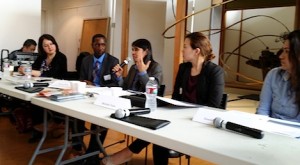But the alphabet soup that has found its way into the national dialogue in recent months was demystified to about a dozen ethnic media reporters by immigration and health care advocates here Dec. 17 so that they in turn could explain it to their communities and urge them to take advantage.
Marielena Hincapié is executive director of the National Immigration Law Center. She called President Obama’s Deferred Action for Parental Accountability (DAPA) program something “that has been fought for and won by immigrants themselves.” And, she noted: “At the end of the day, it’s a life-changing situation for them.”
Announced on Nov. 20 as part of the president’s executive action, DAPA is open to some 5 million undocumented immigrants nationwide – about 1.6 million of them in California. It provides a temporary reprieve from deportation for undocumented parents whose children are American citizens or legal permanent residents, and who have lived in the country for at least five years and have not committed serious crimes. DAPA status is renewable every three years.
The Executive Action also expands DACA (Deferred Action for Childhood Arrivals) by removing the current age ceiling of 31 years. It also increases the DACA renewal period from two to three years.
But like DACA, beneficiaries of the DAPA program will get deportation deferrals and work permits only. They will not be eligible for green cards or any other visa or formal immigration status that only Congress can bestow.
“Although Executive Action is only temporary, the status quo is so unacceptable,” said Hincapié, noting that for an undocumented mother even the simple of act of driving her child to school could be paralyzing: “She is afraid of getting stopped because of racial profiling,” she said.
Still other undocumented immigrants who are eligible for either DACA or DAPA worry that by applying they might bring attention to undocumented relatives not eligible for either program and thus open the way to deportation. But Hincapié assured the audience that no information on the application form is shared with immigration officials.
“That’s where you come in,” she said, urging the reporters in the room to get the word out about this. She told the media that “if more people applied, the more difficult it would be for future administrations … to take it away.”
Still, despite the benefits of DACA, a significant number of eligible immigrants have yet to apply, said Ronald Coleman, California Immigrant Policy Center’s government affairs manager. He pointed out that while around 400,000 youth are eligible for DACA in California, less than 50 percent of them have applied. Coleman speculated part of reason could be because some of those eligible don’t know they are.
“We need to put all our resources out” and let them know about DACA and DAPA, he said, pointing out that there are economic benefits to providing deferred action to undocumented immigrants.
“With work authorization, immigrants will have more economic mobility,” he said. “They could look for jobs that provide employer-based health insurance.”
Even though DACA and DAPA recipients will be excluded from all federally funded health care programs under the Affordable Care Act (ACA), those living in California have the unique advantage of being able to get comprehensive state-funded Medi-Cal if they meet all eligibility requirements. That includes having an income below 138 percent of the federal poverty level ($15, 856 for a single individual).
Twenty-nine-year-old panelist Imelda Plascencia said expanding DACA to allow those who have lived continuously in the United States since January 1, 2010 – instead of the original June 15, 2007 cutoff date – will allow her to enroll in the program. She said that one of the things she’s most looking forward to after applying is enrolling in Medi-Cal so she can get a long overdue physical and dental checkup.
“I’ve been living with gall stones for years,” said Plascencia, who is the project manager of Health Initiatives at the Dream Resource Center, part of the UCLA Labor Center. “Because I don’t have access to health care, I’ve been treating it with pain killers.”
But while speakers praised the president’s move, they also noted those eligible for either program might still have no access to health insurance.
Panelist Michelle Yoon, 23, is a founding member of the Los Angeles chapter of ASPIRE (Asian Students Promoting Immigrant Rights Through Education). She said she got DACA status in 2013, and has employer-funded health insurance. But her 56-year-old mother, who now qualifies for DAPA, will not qualify for Medi-Cal because she makes a “little too much money” as a store salesperson.
Doreena Wong, project director for Advancing Justice – L.A. Health Access Project, lamented that when such programs as DACA and DAPA are rolled out, the Asian and Pacific Islander communities are not targeted because “when people think of undocumented, they think of Hispanic.” Little or no material is provided in Asian languages.
That’s ironic, she said, because there are more foreign-born immigrants from Asia in California (59 percent) than there are from Latin American countries. This is perhaps why “our communities have a higher uninsured rate.”
Coleman pointed out that even with deferred action programs, the status of many undocumented immigrants would remain the same. For example, many in the LGBT communities will not qualify for DAPA since “[deportation] relief is based on family.”
For those left behind, Democratic Sen. Ricardo Lara’s Health Care For All bill would be the answer, he said. The bill, which didn’t make it out of the Senate Appropriation’s Committee earlier this year, was reintroduced by Lara last month.
“We’ve got to focus on making sure that everybody in California is covered,” Coleman said.
The Dec. 17 event was organized by New America Media and the L.A. chapter of Asian Americans Advancing Justiceat the Japanese American Cultural and Community Center.





